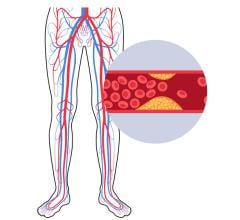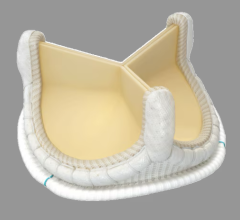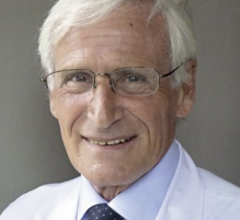
Michel Makaroun, M.D., professor and chief of the division of vascular surgery, University of Pittsburgh Medical Center.
Endovascular repair for aortic aneurysms has gained popularity in the past five to six years as physicians has learned how to use and became more comfortable with the new generations of stent graft technology. “The number of endovascular repairs is going up,” said Michel Makaroun, M.D., professor and chief of the division of vascular surgery, University of Pittsburgh Medical Center, and president of the Association of Chairs in Vascular Surgery, a section of the Society for Vascular Surgery. Today he says between 50-60 of aortic aneurysm repairs are done endovascularly. The first generation of aortic endo repair devices in the mid-1990s had issues with endoleaks, fixation, manufacturing, and in materials used, he explained. Some devices had poor fixation, causing late migration. Some fabrics leaked, stent polishing techniques contributed to fatigue strut failure, and there were questions about how much devices should be overlapped. However, today Mr. Makaroun said aortic endo repair devices have achieved a level of reliability on par with surgical repair. “There have been a lot of advancements over the past 10 years,” Dr. Makaroun said. “The results are getting better and better.” He said in the late 1990s endovascular aortic repairs were usually only stable for about two or three years, but today’s devices offer stability of at least eight or nine years. Better fixation systems have also made migration mostly a thing of the past, Dr. Makaroun said. That is not to say today’s devices are not devoid of problems. He said vessel tortuosity and repairs around side branch vessels still cause issues with the devices, making a proper seal to isolate the aneurysm difficult, or it can risk occluding the collateral vessels. But, he said the next generation of devices hold promise to overcome these issues. “Technologies are now coming out to address areas where we would not have even attempted endovascular repairs a few years ago,” Dr. Makaroun said. “There is practically no region of the aorta that we will not be able to repair endovascularly... In the next few years the envelope of the technology will be pushed with the availability of these new devices.” New devices currently available in Europe, and in some cases working their way through FDA approval in the U.S., will allow repairs near or on top of side branches. This will allow better, long-term device fixation in the more stable area around the renals, Dr. Makaroun said. He said the region of the aorta below the renals tends to be unstable, resulting in aneurysms. Even if stent grafts are placed on a stable area of the aorta below the renals, the vessel can continue to deteriorate and cause leaks or migration. If stents can be fixed around the renals he said the repairs will have a much better longer-term prognosis. The sizes of the devices used for endovascular repair of the aorta have become smaller over the last 15 years, making them more attractive to some interventional cardiologists and making the devices easier to implant without surgical assistance. Dr. Makaroun said the devices in the mid-1990s were 25-26 Fr., today devices are around 18-22 Fr. and new generations of devices are being developed with sizes as small as 14-16 Fr. However, size alone will not determine if more cath labs or interventionalists take on aortic repairs. He said surgeons are still the best qualified because they offer more options to patients and can switch to surgical techniques in case of complications during a procedure if more extensive follow-up repairs are needed. While deployment of stent grafts can be done using a mobile C-arm in an OR for repairs of straightforward anatomy, more detailed procedures or for deployments around collateral vessels and tortuous anatomy require the high quality imaging of a fixed fluoroscopy system. However, since most cath labs do not offer a sterile environment, many hospitals have created hybrid ORs with fixed imaging systems. At the University of Pittsburgh Medical Center Dr. Makaroun said all endovascular aortic repairs are done in a hybrid OR in case surgical interventions are required. He said hybrids are becoming the standard of care in most institutions that have a large number of these repairs.


 January 24, 2025
January 24, 2025 









